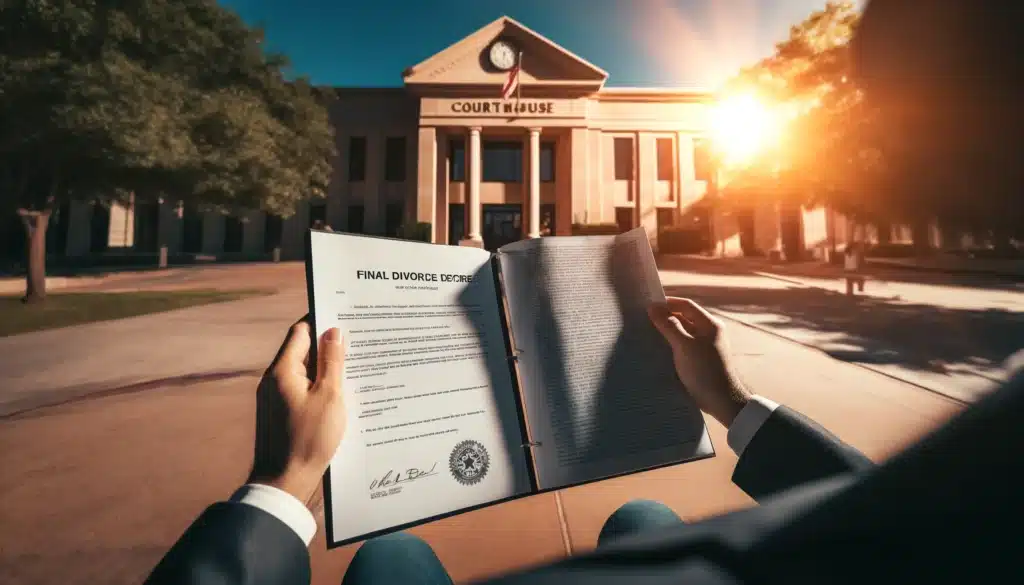
Understanding how to access legal records can feel overwhelming at first. Making sense of where to get divorce decree in Texas: what it means for you is a topic many people find confusing. It may seem like a small detail, but this document plays a major role in your post-divorce life. It affects everything from your personal records to your ability to move forward.
What Is a Divorce Decree?
A divorce decree is the final order issued by the court that legally ends your marriage. It contains all the details of your divorce settlement. This includes property division, custody, child support and spousal maintenance. It is not just a formality. It is an enforceable court order that outlines your rights and responsibilities.
Without a divorce decree, you may struggle to prove that your marriage has ended. Consequently, this can lead to legal delays or complications when trying to update your personal information. For this reason keeping this document safe and readily accessible is absolutely essential.
Why the Decree Matters After Divorce
After your divorce is finalized, life does not always return to normal immediately. You often need to take steps that involve presenting your divorce decree. If you want to change your name, update your Social Security records or apply for a new marriage license, this document is required.
It is also used when refinancing property, adjusting child support or enforcing court orders. Making sense of where to get divorce decree in Texas: what it means for you includes understanding how vital this paperwork is across many areas of your life. Without this official court order you may face delays or denials from government offices, banks or legal professionals.

Where the Decree Is Stored in Texas
In Texas divorce decrees are held by the district clerk’s office in the county where your divorce was finalized. That means you must know the specific county courthouse that handled your case. Each county clerk’s office keeps records for its local family court cases. They do not share documents between counties.
For example, if your divorce was processed in Travis County, your decree will only be available from the Travis County District Clerk’s Office. This applies no matter where you currently live. If you are unsure which county handled your case, try to recall where you or your spouse lived at the time. Most divorces are filed in the county of residence.
How to Request Your Divorce Decree
Requesting a copy of your decree is usually simple. Most county clerk offices offer three main methods: in person, by mail or online. In-person requests are usually faster. You will need to bring a valid photo ID. You may also need to complete a form that includes details such as both spouses’ names, the date of the divorce and the case number if known.
If you choose to request by mail, include a written request with the same information. Enclose payment for the certified copy and a return envelope. Online options vary by county. Many clerk websites now offer secure portals for document requests. Processing times differ depending on how you request the document. In-person requests may be fulfilled the same day. Mail or online requests can take several business days or longer.
| Method | Details |
| In Person | Visit the district clerk’s office. Bring a valid photo ID. May get it same day. |
| By Mail | Send written request with names, date, case number (if known), and payment. |
| Online | Use county website portal to submit request and pay electronically. Takes several days. |
What a Certified Copy Includes
A certified copy of your divorce decree is an official version that includes the clerk’s seal and signature. This confirms that the document is valid for legal use. Most offices charge a small fee for certified copies, usually between $5 and $20.
Certified copies are required for many official processes. If you are applying for government benefits or for instance, submitting legal paperwork, then in many situations a plain copy may not be accepted. As a result it becomes especially important to understand the exact type of documentation required for your specific purpose. In addition, making sense of where to get divorce decree in Texas: what it means for you also includes among other things knowing which version of the decree, certified or otherwise, is needed for different legal or administrative processes. Furthermore, to avoid unnecessary delays, confusion or even rejection of your application you should always ask in advance if a certified copy is required before making your request.

What to Do If You Lost the Case Number
Many people do not keep track of their case number. Fortunately, you can still request a copy of your divorce decree without it. Most clerk offices can search for your case using your full name, your former spouse’s name and the approximate date of the divorce.
You may be asked for proof of identification to protect your privacy. Some counties require a notarized request for mailed documents. Be prepared to provide a government-issued photo ID if requested. If you moved or changed your name after the divorce, it helps to bring or submit documentation to verify your identity. This ensures the clerk can confirm your connection to the case.
Accessing Sealed or Restricted Records
Some divorce cases may be sealed by the court. This typically happens in cases that involve sensitive personal information or private agreements. If your record is sealed you may need a court order to access it.
The process to gain access involves filing a motion with the court that originally handled your divorce. A judge will review your request and decide whether to allow access to the sealed record. You will need to explain why you need the document and how it will be used. This process can take time and often requires legal guidance. If you believe your decree has been sealed, contact the district clerk’s office for instructions.
Avoiding Common Mistakes
People often assume they can get a copy of their decree from any county in Texas. This is incorrect. You must contact the district clerk in the specific county where the divorce was granted. No statewide system exists to provide divorce decrees from multiple counties.
Another common mistake is confusing the divorce decree with a divorce certificate. Texas does not issue divorce certificates. The decree is the only legal record of your divorce. This distinction matters when submitting documents to agencies that require proof of divorce. Making sense of where to get divorce decree in Texas: what it means for you includes understanding these distinctions to avoid delays and errors.
Online Tools and Digital Requests
Many county clerks now offer secure websites where you can submit your request for a divorce decree. You may be able to complete the process without visiting the courthouse. These portals allow you to enter your information, upload identification and pay for your certified copy electronically.
These systems are useful for individuals who no longer live in the county where their divorce occurred. They also provide tracking tools so you can see the status of your request. While convenient, these systems may still require manual verification. If your identity or case d etails are unclear the clerk’s office may contact you for more information.
Using the Decree for Future Needs
Even years after a divorce your decree can still play an important role. You may need to show proof of divorce when refinancing a home or applying for benefits. It is also used in child custody disputes, when requesting spousal support adjustments or when enrolling children in school.
To begin with, keeping at least one certified copy in a secure location is a smart and proactive decision. Not only does this ensure immediate access when needed but it also, at the same time, protects against unexpected emergencies. In addition to physical storage many individuals also choose to store digital versions in secure cloud accounts as a reliable form of backup. As a result they create an extra layer of protection against loss or damage.
Nevertheless, despite the convenience and accessibility of digital files, it is still essential to always keep a physical certified copy readily available especially for formal or legal requests that, in many cases, may not accept digital versions. In fact, many institutions specifically require certified hard copies and will therefore reject electronic alternatives. Furthermore, making sense of where to get divorce decree in Texas: what it means for you also involves among other considerations, thinking ahead, preparing in advance and planning carefully for a wide range of situations in which this critical document may be required again. Whether weeks, months or even years after your divorce is finalized.
What to Do If You Divorced Outside Texas
If your divorce took place in another state, Texas courts and clerks cannot provide your decree. You must contact the county or state agency where the divorce was finalized. Every state has its own process for storing and distributing court records.
Once you obtain a certified copy from the original jurisdiction, you may use it in Texas for legal purposes. Be aware that timelines and fees may vary by state. If your divorce occurred many years ago retrieval may take additional time. It is important to begin the request process early if you need the decree for an upcoming legal or financial matter.

When Legal Help Is Necessary
Sometimes getting your decree is more complicated than expected. This can happen when the case involved multiple filings, sealed documents or outdated records. In such cases it is best to consult an attorney.
Lawyers who handle family law matters often know how to work with county clerks and courts. They can assist with filing motions, confirming your rights and retrieving important documents. This support can be valuable, especially when time is limited or when court requirements are unclear
Processing Times and Fees
Fees for certified copies vary by county but are generally affordable. Most counties charge per page or per certified copy. It is smart to check the exact fee before submitting your request.
Processing times can range from same-day to several weeks, depending on the county and the method of request. In-person requests are the fastest but not always possible for those who live far away. Mail and online requests may take longer, especially during holidays or peak court activity. Plan ahead if you need the decree for a deadline. Allow extra time in case of delays.
Keeping Your Legal Records Organized
After your divorce it is helpful to organize your legal records. Keep copies of the decree, any court orders and legal correspondence. Label them clearly and store them in a safe place. This will help you avoid repeated requests or lost paperwork in the future.
It is also wise to update your personal records after the divorce. This includes your name on identification, financial accounts and legal documents. Your divorce decree serves as the proof required to complete these changes. By maintaining a secure and organized record of your decree you protect your rights and simplify future tasks.
Final Thoughts
Making sense of where to get divorce decree in Texas: what it means for you is a key step in managing your post-divorce responsibilities. It ensures you can access legal rights, meet official requirements and move forward with confidence.
From requesting the right type of copy to understanding how the decree affects future decisions, being informed gives you control. The process may involve some paperwork and patience but the result is worth the effort. By following the steps outlined above you can retrieve your decree and keep it ready for any moment when it matters most. Stay prepared, stay organized and take charge of your legal future with the right information at your fingertips.
Other Related Articles:
- Examining the Process for Modifying a Divorce Decree in the State of Texas
- Everything You Need to Know About Texas Divorce Decree Modification
- Your Guide on How to Get a Copy of Divorce Decree in Texas: A Step-by-Step Process
- Everything You Need to Know About Amending Divorce Decree in Texas
- Step-by-step Guide on How to File Contempt of Divorce Decree in Texas
- How to Correct Clerical Errors in Divorce Decrees with Nunc Pro Tunc Judgments
- Inside the Divorce Decree: What You Need to Know
- Navigating Your Divorce Decree Texas: A Comprehensive Guide
- Deciphering Your Texas Divorce Decree: Key Insights and Advice
- The Power of Paper: Your Divorce Decree Unveiled!





